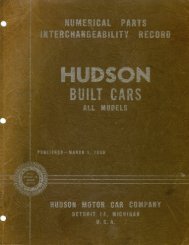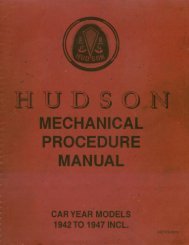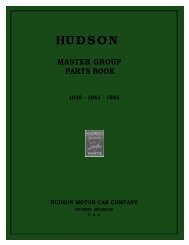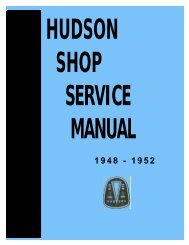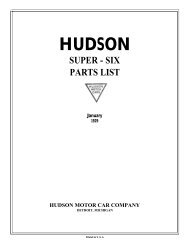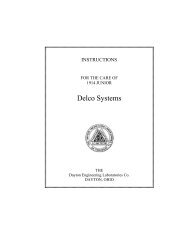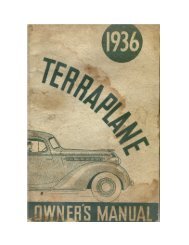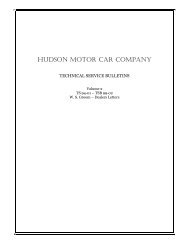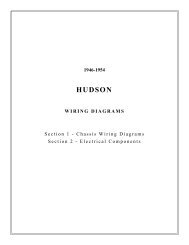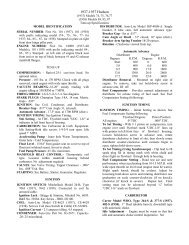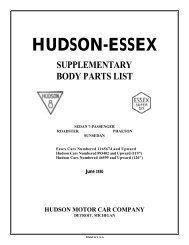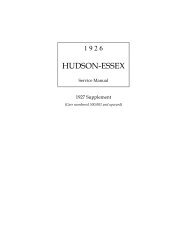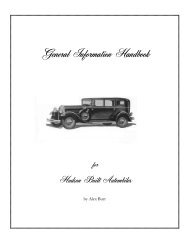1956 AMC Hudson Technical Service Manual Supplement
1956 AMC Hudson Technical Service Manual Supplement
1956 AMC Hudson Technical Service Manual Supplement
Create successful ePaper yourself
Turn your PDF publications into a flip-book with our unique Google optimized e-Paper software.
HYDRA-MATIC TRANSMISSION 29<br />
bracket located at the lower end of the steering gear jacket<br />
tube. Contact can only be made in the "P" (Park) or "N"<br />
(Neutral) positions. Press the foot accelerator pedal, part<br />
way to the floor board once and release (in order to set the<br />
Automatic Choke on fast idle).<br />
Turn the ignition switch "ON" and lift the selector knob<br />
toward the steering wheel to engage the starter.<br />
NOTE: Do not start a cold engine with throttle wide open<br />
(accelerator pedal fully depressed). This overrules the automatic<br />
choke and prevents the engine from breathing in a<br />
mixture rich enough to start.<br />
If engine should flood (because of attempting to start with<br />
ignition off, or because of "pumping" accelerator) operate<br />
engine starter with accelerator pedal fully depressed. Press<br />
accelerator down slowly to reduce tendency for more raw<br />
gasoline to be pumped into the manifold. Opening throttle<br />
wide overrules choke mechanism and opens choke valve,<br />
thereby admitting more air so that starting becomes possible.<br />
In cold weather (0°F. or colder) the engine must<br />
idle with the selector lever in "P" (Park) or "N"<br />
(Neutral) position until engine and transmission are<br />
warmed up.<br />
This can more safely be done in the "P" (Park) position as<br />
the transmission will then keep the car from rolling on a<br />
grade or incline. When the engine is cold and running on fast<br />
idle, the car will tend to creep when the selector lever is<br />
moved to a driving position. A slight application of the foot<br />
brake or hand brake will hold the car until motion is desired.<br />
OPERATING IN "D" RANGE<br />
"D" Range has two positions, Drive 4 and Drive 3. The<br />
selector lever can be moved at will from one position to the<br />
other at any car speed on dry roads where traction is good.<br />
Drive 4 is provided for all normal forward driving; it reduces<br />
engine speed, provides better driving comfort and improves<br />
fuel economy. When driving in this range at a car speed of<br />
less than 65 M.P.H., extra performance can be obtained by<br />
depressing the accelerator pedal. This will cause the transmission<br />
to downshift into third speed. The car speed determines<br />
the amount the accelerator pedal must be depressed to<br />
cause this shift. At a speed of 35 M.P.H. or less, the accelerator<br />
pedal need only be partially depressed to cause the shift<br />
and at speeds of 35 M.P.H. to 65 M.P.H., it is necessary to<br />
completely depress the pedal. The transmission will automatically<br />
return to fourth speed as car speed is increased or<br />
the accelerator pedal is released.<br />
Drive 3 is provided for improved performance at medium<br />
car speeds and is very useful when driving in congested<br />
traffic. In this range, the transmission is prevented from<br />
shifting into fourth speed (except at very high car speeds). In<br />
effect, it becomes a three speed transmission in Drive 3<br />
Range. It is also effective when ascending or descending<br />
long mountain grades.<br />
When driving the car in either Drive Range at a car speed of<br />
less than 24 M.P.H., an extra burst of speed can be obtained<br />
by completely depressing the accelerator pedal. This will<br />
cause the transmission to shift down to second speed. The<br />
transmission will automatically return to third or fourth<br />
speed, depending on the Drive Range being used, as the car<br />
speed increases, or pedal is released.<br />
Variable shifting events from first to second, second to third,<br />
third to fourth, (Direct Drive) will occur depending on the<br />
amount the accelerator pedal is depressed.<br />
CAUTION: Do not coast with the selector lever in "N"<br />
(Neutral) position. It is unlawful in some states and sometimes<br />
is harmful to the transmission.<br />
FORCED DOWNSHIFT<br />
To obtain extra power or acceleration when driving in D-4,<br />
D-3 or "L" range, depress accelerator pedal completely.<br />
When in D-4 Range and with a car speed of less than 60<br />
M.P.H., transmission will shift down to third speed.<br />
When in D-3 range and with car speed of less than 20<br />
M.P.H., transmission will shift down to second speed.<br />
STOPPING THE CAR<br />
Leave the selector lever in the driving position selected and<br />
release accelerator pedal. The engine is then left "in gear"<br />
which helps to slow down the car. For further stopping<br />
effort, apply the brakes in the conventional manner.<br />
CAUTION: When the driver leaves the car with the engine<br />
running, the selector lever should always be placed in the<br />
"P" (Park) position.<br />
This precaution prevents movement of the car, should the<br />
accelerator pedal be accidentally depressed by a passenger<br />
and will also keep the car from rolling on a down grade or<br />
incline.<br />
OPERATING IN "L" RANGE<br />
Low Range prevents the transmission from shifting above<br />
2nd speed (unless the car exceeds approxi-



